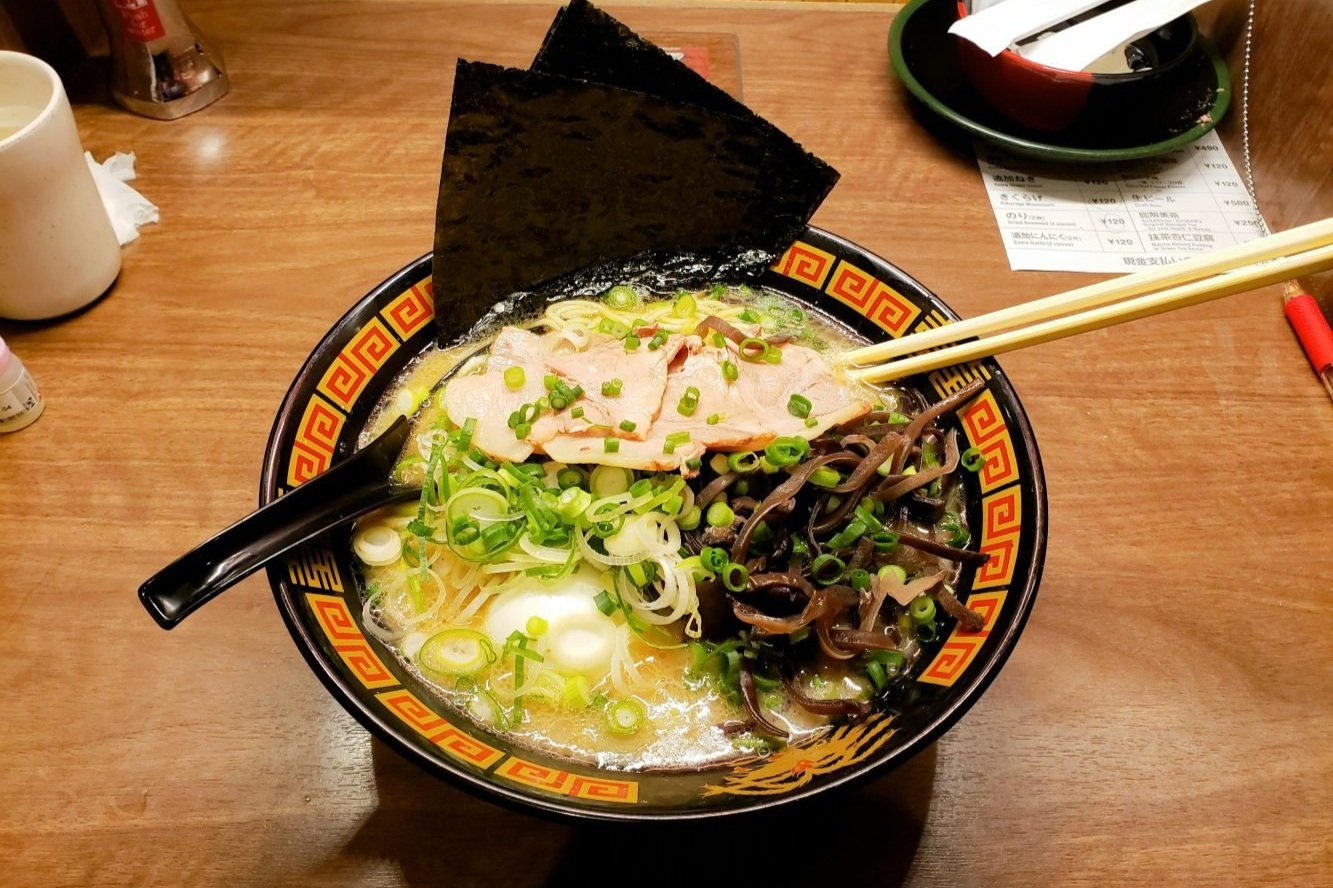The Complete History of Ramen
Ichiran Ramen│© Crystal Jo
With a history steeped in migration, adaptation, and cultural fusion, few dishes can claim the kind of global presence that ramen enjoys today. From humble street stalls in China and Japan to trendy, high-end restaurants in cities around the world, ramen has evolved far beyond its origins. These bowls of comfort carry echoes of ancient Chinese noodle traditions, the industrial boom of Japan, and the hardships of post-war survival.
In this article we’ll dive deep into the rich history of ramen, tracing its roots back to ancient China, following its evolution and exploring how this once humble noodle soup has conquered the entire world. From ramen’s cultural significance in anime and manga to its rising status as a gourmet dish, we’ll leave no stone unturned.
In this article
Chinese Roots
Emergence of Ramen in Japan
Post-World War II
Regional Ramen Variations
Yokohama and the Founding of Iekei Ramen
The Instant Ramen Revolution
Ramen Going Global
The Future of Ramen
Chinese Roots
The noodles that would shape ramen as we know it are the lamian, characterized by their chewy texture, made through a process of stretching and pulling the dough. The earliest known reference to the method of hand-pulling noodles comes from a dietary guide written in 1504 by Ming dynasty scholar Song Xu. This text, Songshi Yangsheng Bu, offers one of the first detailed accounts of the technique.
Fast forward to the 19th century, when the Meiji Restoration opened Japan’s doors to the world. This era wasn’t just about Westernization; it ushered in an influx of Chinese immigrants, particularly from the Pearl River Delta and Taiwan, who carried their rich culinary traditions along with them. The seeds of ramen were sown as these immigrants set up noodle shops in bustling port cities like Yokohama and Kobe, introducing Japanese palates to their flavorful creations.
Emergence of Ramen in Japan
The first documented mention of a noodle soup resembling ramen traces back to the late 17th century. According to historical accounts, a Chinese Confucian scholar prepared a bowl of steaming noodles in broth for Lord Tokugawa Mitsukuni, a member of the ruling Tokugawa clan. Though this dish was a precursor to modern ramen, it bore little resemblance to what we enjoy today.
It wasn’t until the early 20th century that ramen as we know it began to take shape. In 1910, the first dedicated ramen shop, then called Rairaiken, opened in Asakusa, Tokyo. The shop was founded by a former customs official who had been influenced by Chinese culinary techniques while working at the Yokohama port, an area known for its foreign influences. This establishment was crucial in transforming ramen from a Chinese-inspired dish into a uniquely Japanese creation. Over time, the term ramen—a Japanese phonetic adaptation of the Chinese word for pulled noodles—became widespread. As urbanization accelerated, particularly after Japan’s Meiji Restoration and subsequent industrial growth, ramen began to appeal to the masses, becoming a quick, convenient meal for city dwellers.
As Japan industrialized in the early 20th century, the demand for inexpensive and filling meals surged, particularly among the burgeoning working class. Ramen, with its hearty broth, wheat noodles, and meat toppings, was a perfect solution for laborers and factory workers who needed quick, energy-dense meals. Street food vendors, often using mobile carts known as yatai, quickly capitalized on this demand, setting up shop near factories, docks, and bustling urban centers. By the 1920s, ramen had evolved from an obscure dish to a fundamental meal in Japan’s urban landscape.
Keyaki Ramen Sapporo│© City Foodsters
The Great Kanto Earthquake of 1923 played a surprising role in the rise of ramen. In the aftermath of the disaster, the reconstruction efforts led to the proliferation of makeshift food stalls, as displaced workers and residents needed affordable meals. These yatai often served ramen, which was both cheap to produce and filling. For many, ramen symbolized resilience, providing a warm, nourishing meal during hard times. This period also saw the dish’s regional variations begin to take form, as different areas in Japan adapted the recipe to local ingredients and tastes, setting the stage for ramen’s rich diversity today.
Post-World War II
The aftermath of World War II marked a watershed moment for Japan’s food landscape, transforming ramen from a regional specialty into a national phenomenon. Japan was left devastated by the war, facing widespread food shortages, inflation, and the challenge of feeding a starving population. Rice became scarce due to both agricultural damage and inadequate supply chains. In this crisis, the occupying U.S. forces played an unexpected role in shaping Japan’s post-war diet by introducing surplus wheat flour as part of food aid. Wheat-based products like bread and noodles became essential replacements for rice, contributing to the growing popularity of ramen.
At the same time, the Japanese government implemented strict rationing policies, yet they couldn’t meet the needs of the people, giving rise to an underground food economy. The affordable and filling ramen made with the readily available wheat, became a symbol of survival. Illegal street vendors (yami-ichi) flourished, often operating in the shadows to avoid detection from the authorities. These vendors would set up mobile yatai and sell ramen to workers, students, and families who had limited access to government-distributed rations. Many of these ramen stalls sourced ingredients through the black market, using pork fat, soy sauce, and wheat-based noodles to create nourishing meals that offered a semblance of comfort during harsh times.
As Japan’s economy began to recover in the 1950s, the rise of ramen mirrored the country’s post-war resurgence. The street vendors who once operated illegally gradually transitioned into legitimate businesses, setting up the first wave of ramen shops, many of which are still in operation today. The dish’s affordability and comforting qualities made it a favorite among the burgeoning urban working class, and it quickly became a cornerstone of Japanese street food culture.
Keyaki Ramen Sapporo│© City Foodsters
Regional Ramen Variations
As ramen’s popularity surged across Japan, distinct regional styles blossomed, each showcasing unique local ingredients and culinary traditions. Let’s dive into some of the most popular varieties:
Tonkotsu Ramen
Originating from Fukuoka, this style features a rich, creamy broth derived from simmering pork bones for hours, resulting in a deeply flavorful stock, often paired with thin, straight noodles. Toppings typically include chashu, green onions, and soft-boiled eggs.
Shoyu Ramen
This soy sauce-based variant is synonymous with Tokyo. With a clear, flavorful broth that balances sweetness and saltiness, shoyu ramen usually features curly noodles garnished with nori (seaweed), menma (bamboo shoots), and fresh green onions.
Miso Ramen
Hailing from Sapporo, this hearty style boasts a broth enriched with fermented soybean paste, often topped with corn, butter, and bean sprouts, delivering a robust and satisfying experience.
Shio Ramen
Known for its clear, salty broth, shio ramen is lighter than its counterparts and originated from various coastal regions, typically garnished with fish cakes and fresh herbs.
Hakata Ramen
A variation of tonkotsu, Hakata ramen is famous for its ultra-thin, straight noodles served in a rich, milky pork bone broth, often accompanied by pickled ginger and spicy mustard greens.
Tsukemen
A unique style where noodles and broth are served separately, allowing diners to dip the noodles into the concentrated, flavorful broth, providing an unparalleled texture and flavor experience.
Tsukemen Ramen│© City Foodsters
Yokohama and the Founding of Iekei Ramen
Being one of the first points of contact between Japan and the outside world during the Meiji Restoration, Yokohama became a melting pot of international influences, particularly Chinese culinary traditions. It was in this city, with its bustling Chinatown and thriving international community, that ramen began to solidify its identity as a uniquely Japanese dish, incorporating local tastes and ingredients.
The 1970s saw the birth of a new style of ramen that would further cement Yokohama’s significance in ramen history—Iekei ramen (家系). This style was founded by Yoshimura Minoru in 1974 when he opened the now-iconic Yoshimuraya ramen shop in Yokohama. Iekei ramen is renowned for its rich, creamy broth that blends shoyu with tonkotsu (pork bone broth), creating a deeply savory and robust flavor profile. The noodles are thicker and chewier, reminding of the Chinese lamian, and the dish is typically topped with spinach, chashu (roasted pork), and nori (seaweed), giving it a hearty, satisfying taste. Iekei ramen’s popularity quickly spread, spawning a wave of copycat shops and regional variations across the country.
Yokohama’s legacy in ramen history doesn’t end with Iekei ramen—it is also home to the Shinyokohama Ramen Museum, an institution dedicated to the preservation and celebration of ramen’s rich history. Opened in 1994, the museum features a nostalgic recreation of post-war Tokyo and offers visitors the chance to taste different regional varieties of ramen, from Hokkaido’s miso ramen to Kyushu’s tonkotsu.
In many ways, Yokohama represents the crossroads where ramen’s historical roots and modern innovations meet.
Iekei Ramen│© Ivva
The Instant Ramen Revolution
A seismic shift in ramen’s narrative occurred in 1958 when the visionary Momofuku Ando introduced instant ramen to the world. Through relentless experimentation, he discovered that flash-frying noodles allowed them to rehydrate swiftly when boiled. This breakthrough transformed ramen from a restaurant staple into a pantry essential in homes across Japan—and eventually, the globe.
Instant noodles coincided perfectly with a changing lifestyle; as the pace of life quickened, convenience foods like instant ramen became indispensable. Ando’s creation was not just affordable but also remarkably versatile, boasting flavors ranging from classic chicken to zesty seafood, appealing to diverse tastes. By 1971, the introduction of cup noodles further revolutionized the ramen experience, making it even easier to enjoy on the go.
Cup Noodle│© frogses production
Ramen Going Global
The 1980s and 1990s saw a wave of Japanese cuisine gaining popularity in Western countries, thanks in part to the Nikkei movement, which celebrated Japanese culinary practices abroad. Sushi was the initial ambassador, but ramen soon followed. As more Japanese chefs opened restaurants in cities like New York, San Francisco, and Los Angeles, they brought authentic ramen recipes with them, allowing local diners to experience the dish in its true form.
A key turning point came in the early 2000s, particularly with chefs like David Chang. When he opened Momofuku Noodle Bar in 2004, Chang elevated the dish to fine dining status. By focusing on high-quality ingredients and unique flavor combinations, he introduced ramen to a new audience, launching a ture ramen renaissance.
The impact of social media cannot be overstated. Platforms like Instagram and food blogs allowed ramen to reach a wider audience, transforming it into a visual experience as much as a culinary one. Diners began sharing their ramen adventures, showcasing beautifully presented bowls and unique toppings, which in turn inspired chefs to innovate even further.
High end Ramen│© Kanesue
The Future of Ramen
Ramen is no longer just a simple noodle soup; it has evolved into a global phenomenon, reflecting shifts in culture, dietary preferences, and culinary innovation. As we look to the future of ramen, we see a landscape rich with possibilities, influenced by both tradition and modernity.
The growing movement toward health-conscious eating has led to the rise of vegetarian and vegan ramen options. Chefs are creatively substituting traditional meat-based broths with umami-rich alternatives made from mushrooms, seaweed, and even fermented vegetables. For instance, a shiitake mushroom broth can provide the depth typically associated with pork or chicken broth, appealing to both vegetarians and those looking to reduce their meat consumption.
Moreover, the use of alternative noodles—such as those made from zucchini, rice, or even legumes—has gained popularity. These innovations cater to gluten-free diets while maintaining the essential characteristics of ramen. Brands are also experimenting with whole-grain noodles and fortifying them with protein to enhance their nutritional profile.
Vegan Ramen│© Zoshua Colah
From its humble beginnings as a simple noodle soup to its iconic status in the culinary world, ramen is a dish rich with history and cultural significance. Each bowl serves as a reminder of migration, adaptation, and the beautiful melding of flavors from various cultures.
So, the next time you enjoy a bowl of ramen—whether at a tiny eatery in Tokyo or a trendy restaurant in New York—take a moment to appreciate the incredible journey this dish has undertaken.















Before Harajuku, Shoichi Aoki archived the world’s fashion.